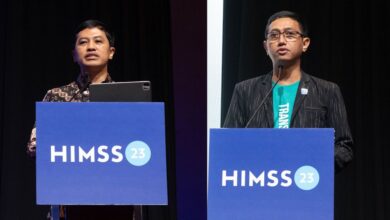How Epic is using AI to change the way EHRs work


Editor’s Note: This is the fourth in a series of features on top voices in health IT discussing the use of artificial intelligence in healthcare. To read the first feature, on Dr. John Halamka at the Mayo Clinic, click here. To read the second interview, with Dr. Aalpen Patel at Geisinger, click here. To read the third, with Helen Waters of Meditech, click here.
Sumit Rana, executive vice president of research and development at electronic health records company Epic, is working in one of the centers of artificial intelligence efforts in health IT. His days are filled with, among other things, creating ways AI can help doctors and nurses today and into the future.
Epic is using AI and ambient listening technology in an effort to improve patient-provider interactions. It’s enabling physicians to generate progress notes from a patient-provider conversation in the exam room. It’s allowing doctors to instantly create a draft response to a patient’s question. It’s showing providers what’s new with a patient since they last saw the patient. And it’s working on AI assisting staff with medical coding.
Healthcare IT News sat down with Rana for a deep dive into all these uses of artificial intelligence and more.
Q. Epic is using AI and ambient listening technology with the aim of improving patient provider interactions. Some health IT leaders at provider organizations have concerns. Are these technologies reliable today?
A. I call myself a skeptical optimist. It’s always good to ask questions. I think context matters here. Oftentimes, AI tools, particularly generative AI, can be used to help people be more efficient. And in these contexts, for example, drafting a potential response to a message from a patient, it’s very important the AI always keeps the physician in the loop. These tools are then very helpful.
I have a few rules of thumb. First, is the AI tool entirely automating the process, or is there a human in the loop who makes the final decision? Be wary of the former. It needs to hit a much higher bar. Second, from a user experience standpoint, is it always clear the software is clearly highlighting if and when AI is involved and how it’s involved?
And then I think the third part is does the application provide sufficient auditing and monitoring data for tracking both the AI use and associated outcomes and decisions in the workflow?
Q. Speaking specifically to Epic, your EHR now uses AI to generate progress notes from patient/provider conversations in the exam rooms. Please elaborate on how this works and the outcomes you’re seeing.
A. So, the physician asks the patient at the beginning of the visit if they can record the visit to help with documentation, and most patients are okay with it. And then after that, what they do is they turn that on, on their cell phone application.
If needed, they can at any time instruct the AI to stop listening or start again, depending on if there’s something the patient’s not comfortable with. The AI is listening to that ambient conversation. And then once that conversation is done, a few moments later, what happens is the note gets updated with a draft of what was discussed, and then a physician can review that note, make changes similar to what they might do in a dictation workflow, and then they finalize their documentation.
This is being used at over 30 sites now, and I want to share just some outcomes from a few of the sites. So, one site reported average savings of five-and-a-half hours per week. Another one looked at time spent by doctors after clinical hours, and they saw a 76% reduction in that time spent after clinic hours, which is, I think, fairly substantial.
And then a third site said over 60% of their users reported increase in documentation quality. I think that’s another good aspect to look at in terms of how well written the notes are.
Q. Your provider users can use AI to generate a draft response to a patient’s question. How does this work and what kinds of results are you seeing?
A. The way this works is that as the provider opens a message from a patient, a draft is there waiting for them, and they only have two choices. They can either start with the draft and then make changes to it as they see fit, or they start with a blank text box, which is how it used to be. You hit reply and then you type in a message.
A response is never automatically sent, so start with the draft or start with blank text. And in terms of results, we have some sites trying to do deeper qualitative studies on this, but I’ll share some early feedback.
What we’ve heard from providers first is that providers like that the AI can pre-fetch data in the patient’s chart and synthesize it for them. They’ve reported they spend less time foraging for data themselves. They also report it helps sometimes overcome writer’s block, and that it creates more descriptive and likely more empathetic responses to patients.
Finally, we had to teach the AI to write in the doctor’s voice. For example, you might have a doctor who says, “Dear Bill.” Another one might say, “Hi, Bill.” A third one might say just “Bill,” and a fourth one might not say your name at all. And if the writing style does not mirror what the patient is used to from that provider, it can feel very unnatural. So, we have to also teach the AI to do that.
Q. It’s interesting you say that AI can sometimes be more empathetic.
A. There was one early example where there was a patient who had been on vacation on a different continent, I think in Europe, and had sent a message. And the AI not only drafted a response, but one of the things the response included was something along the lines of, and I’m paraphrasing, “I’m sorry you’re going through this, I hope your vacation has been good.”
And the physician said, “Boy, I don’t know if in my busy time I would have written that.” But it does in fact enhance that human connection, and it’s a good thing to write.
So, I think it’s not as much that folks are not otherwise empathetic, it’s that when you have a busy day and you’re seeing patient after patient, sometimes it’s harder to write those type of messages. And if the AI can help, that’s a good thing, and it enhances that relationship.
Q. How does AI in your EHR show a provider what’s new with a patient since they last saw them?
A. There have been many options for doing this in the system even prior to generative AI. But I’ll talk about what we’re doing with generative AI.
So, our users are beginning to explore a new feature we have added where we summarize prior notes in the chart. And the key thing here is the summary has to be specific to the context of the physician and the care setting.
For example, if you are an ED triage, how you summarize and what you choose is going to be different than if you’re doing a physical after five years. And summarization definitionally means you’re going to discard facts. And so, what facts to keep? What facts to discard matters based on that context.
The other big learning we had was that it’s super important for the provider to be able to hover and see citations so they can see not only what the summary is, but what facts within the medical record were used to generate this summary.
And this is critical from our perspective to limit the risk of hallucinations that I mentioned earlier and improve the confidence in the technology.
Q. How is Epic using AI to assist with medical coding? What have been the outcomes to date?
A. The AI will list potential procedure and diagnosis codes based on clinical documentation, and then it allows a coder to easily add that to the charging session without having to start from scratch for each visit and for each suggested code.
It also highlights supporting documentation in the chart without having to again go hunting and gathering for it. In terms of outcomes, it isn’t available for production use yet. We’re gearing up to release it.
Our initial testing internally has shown that generative AI is quite effective at taking free text clinical documentation and translating it to discrete codes for billing. This is going to make the coding workflow more efficient.
More generally, it’s one of the things we’re doing to reduce administrative overhead for organizations, and we expect to automate more and more of these sorts of administrative tasks in the future.
Editor’s Note: To watch the video of this interview, which contains bonus content not in this story, click here.
Follow Bill’s HIT coverage on LinkedIn: Bill Siwicki
Email him: [email protected]
Healthcare IT News is a HIMSS Media publication.




